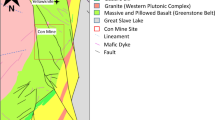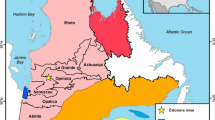Abstract
After the closure of an underground mine, tunnels commonly become flooded and can be potentially exploited for its geothermal resource. Developing new methods for quantifying the energy content of this reservoir with a complex geometry is important to assess the economic value of its heat resource. The objective of this paper is to provide a first-order assessment of the geothermal potential of an underground mine using the Con Mine near Yellowknife, Northwest Territories, Canada, as an example. Field data allowed the development of an improved analytical approach to evaluate the geothermal potential of the Con Mine based on a thermal power budget. The sources considered in the thermal power budget are the thermal inertia of the water in the mine and the surrounding host rock, and the water that infiltrates the mine from nearby lakes. Analytical calculations are based on the finite linear heat source equation, considering cooled or heated water in the mine tunnels as heat sources or sinks. The geometry of the underground mine is consequently simplified to a linear heat source of equivalent length and fixed radius. The Thiem equation is used to calculate the water seeping into the mine. Results obtained with this approach and considering the operation of a geothermal heat pump system indicate a total energy of 17,520 MWh y−1 and 8234 MWh y−1 that can be delivered to buildings for heating and cooling purposes, respectively. This new approach provides an improvement to the volumetric method commonly used to assess geothermal resources.







Similar content being viewed by others
References
Andrews, B. J., Cumberpatch, Z. A., Shipton, Z. K., & Lord, R. (2020). Collapse processes in abandoned pillar and stall coal mines: Implications for shallow mine geothermal energy. Geothermics, 88, 101904.
Banks, D., Steven, J. K., Berry, J., Burnside, N., & Boyce, A. J. (2019). A combined pumping test and heat extraction/recirculation trial in an abandoned hematite ore mine shaft, Egremont, Cumbria, UK. Sustainable Water Resources Management, 5(1), 51–69.
Banks, D., Steven, J., Black, A., & Naismith, J. (2022). Conceptual modelling of two large-scale mine water geothermal energy schemes: Felling, Gateshead, UK. International Journal of Environmental Research and Public Health, 19(3), 1643.
Bao, T., Meldrum, J., Green, C., Vitton, S., Liu, Z., & Bird, K. (2019). Geothermal energy recovery from deep flooded copper mines for heating. Energy Conversion and Management, 183, 604–616.
Bloemendal, M., & Hartog, N. (2018). Analysis of the impact of storage conditions on the thermal recovery efficiency of low-temperature ATES systems. Geothermics, 71, 306–319.
Cengel, Y., & Boles, M. (2006). Thermodynamics. An engineering approach (5th ed.). McGraw-Hill.
Chu, Z., Dong, K., Gao, P., Wang, Y., & Sun, Q. (2021). Mine-oriented low-enthalpy geothermal exploitation: A review from spatio-temporal perspective. Energy Conversion and Management, 237, 114123.
Cimmino, M., Bernier, M., & Adams, F. (2013). A contribution towards the determination of g-functions using the finite line source. Applied Thermal Engineering, 51, 401–412.
Crawley, D. B., Pedersen, C. O., Lawrie, L. K., & Winkelmann, F. C. (2000). EnergyPlus: Energy simulation program. ASHRAE Journal, 42, 49–56.
Cumming, W. (2016). Resource conceptual models of volcano-hosted geothermal reservoirs for exploration well targeting and resource capacity assessment: Construction, pitfalls and challenges. GRC Transactions, 40, 623–638.
Díez, R. R., & Díaz-Aguado, M. B. (2014). Estimating limits for the geothermal energy potential of abandoned underground coal mines: A simple methodology. Energies, 7(7), 4241–4260.
Doughty, C., Hellström, G., Tsang, C. F., & Claesson, J. (1982). A dimensionless parameter approach to the thermal behavior of an aquifer thermal energy storage system. Water Resources Research, 18(3), 571–587.
Duwiquet, H., Arbaret, L., Guillou-Frottier, L., Heap, M. J., & Bellanger, M. (2019). On the geothermal potential of crustal fault zones: A case study from the Pontgibaud area (French Massif Central, France). Geothermal Energy, 7(1), 1–29.
Energy Plus. (2021). All Regions—North and Central America (WMO Region 4)—Canada—Northwest Territories (9.4.0) [Computer software]. Energy plus. Philadelphia. https://energyplus.net/. Accessed 2 Sept 2020.
Engineering Climate Services. (2021). Engineering Climate Datasets. Canada. https://climate.weather.gc.ca/prods_servs/engineering_e.html. Accessed 5 Oct 2021.
Eyerer, S., Schifflechner, C., Hofbauer, S., Bauer, W., Wieland, C., & Spliethoff, H. (2020). Combined heat and power from hydrothermal geothermal resources in Germany: An assessment of the potential. Renewable and Sustainable Energy Reviews, 120, 109661.
Ferket, H., Laenen, B., Harcouët-Menou, V., Lagrou, D., & Van Tongeren, P. (2012). Presentation. Evaluation of Con Mine energy resource. VITO. Yellowknife.
Ghomshei, M. (2007). Geothermal energy from Con Mine for Heating the City of Yellowknife, NWT: A concept study. 18. University of British Columbia. Yellowknife.
Grant, M. (2010). Geothermal resource proving criteria. In Proceedings World Geothermal Congress, 4 pp. Netherlands.
Grasby, S., Allen, D., Bell, S., Chen, Z., Ferguson, G., Jessop, A. M., Kelman, M., Ko, M., Majorowicz, J., Moore, M., Raymond, J., & Therrien, R. (2012). Geothermal energy resource potential of Canada, Geological Survey of Canada, 2012, Open File 6914 (revised), 322 pp. https://doi.org/10.4095/291488
INTERA. (1997). Hydrogeological and hydrogeochemical study of the miramar con mine. Technical report. INTERA consultants. Ottawa.
Jardón, S., Ordóñez, A., Álvarez, R., Cienfuegos, P., & Loredo, J. (2013). Mine water for energy and water supply in the central coal basin of Asturias (Spain). Mine Water and the Environment, 32(2), 139–151.
Jessop, A. M., MacDonald, J. K., & Spence, H. (1995). Clean Energy from abandoned mines at Springhill, Nova Scotia. Energy Sources, 17(1), 93–106.
Jiang, D., Chen, S., Liu, W., Ren, Y., Guo, P., & Li, Z. (2021). Underground hydro-pumped energy storage using coal mine Goafs: system performance analysis and a case study for China. Frontiers in Earth Science, 9, 760464.
Lawless, J. (2010). Geothermal lexicon for resources and reserves definition and reporting (2e éd.). Australian Geothermal Energy Group. The geothermal Code Committe. Adelaide. https://www.petroleum.sa.gov.au/media/shared/pdf/geothermal/ageg_tigs/tig_02/Geothermal_Lexicon_2010.pdf
Miramar Con Mine Ltd. (2007). Miramar Con Mine, Ltd. Final closure and reclamation plan (p. 302). Technical report. Yellowknife. Miramar Con Mine Ltd. https://bit.ly/3air9IE. Accessed 3 Apr 2020.
Luo, J., Xue, W., & Lu, X. (2021). Characterization of the hydrothermal potential for the cap strata of Yangzte Block (YB), China. Geothermics, 96, 102148.
Menéndez, J., Ordóñez, A., Álvarez, R., & Loredo, J. (2019). Energy from closed mines: Underground energy storage and geothermal applications. Renewable and Sustainable Energy Reviews, 108, 498–512.
Muffler, P., & Cataldi, R. (1978). Methods for regional assessment of geothermal resources. Geothermics, 7(2), 53–89.
Ngoyo Mandemvo, D. (2022). Potentiel géothermique des mines inondées: étude de la mine Con (p. 153). Master’s Thesis. Institut national de la recherche scientifque. Quebec city.
Ofoegbu, G., Read, R., & Ferrante, F. (2008). Bulking factor of rock for underground openings. Book. Center for Nuclear Waste Regulatory Analyses. San Antonio. https://www.nrc.gov/docs/ML0807/ML080700314.pdf
Philippe, M., Bernier, M., & Marchio, D. (2009). Validity ranges of three analytical solutions to heat transfer in the vicinity of single boreholes. Geothermics, 38(4), 407–413.
Popov, Y. (2017). Thermal conductivity (TC) and Thermal diffusivity (TD) scanner (Allemagne). TCS - Lippmann and Rauen GbR. Manual. Schaufling. http://www.geophysik-dr-. rauen.de/tcscan/downloads/TCS-Manual.pdf. Consulté, le 07/08/2021.
Preene, M., & Younger, P. L. (2014). Can you take the heat? – Geotherma energy in mining. Mining Technology, 123(2), 107–118.
Purba, D., Nugraha, R. P., Adityama, D. W., Ayuningtyas, R. R., Chandra, V. R., Al-Hassan, M. A., Ramadhan, R. F., Rizqy, M. M. (2021). Resource assessment methods selection for geothermal exploration project in Indonesia: What are the consideration? In Proceedings in 46th workshop on geothermal reservoir engineering Stanford University, Stanford, California, February, pp. 15–17.
Raymond, J. (2018). Colloquium 2016: Assessment of subsurface thermal conductivity for geothermal applications. Canadian Geotechnical Journal, 55(9), 1209–1229.
Sanyal, S., & Sarmiento, Z. (2005). Booking geothermal energy reserves. Geothermal Resources Council Transactions, 29, 467–474.
Silke, R. (2009). The operational history of mines in the Northwest territories. Technical report. N.W.T. Geoscience Office Yellowknife. Yellowknife.
Song, H., Xu, J., Fang, J., Cao, Z., Yang, L., & Li, T. (2020). Potential for mine water disposal in coal seam goaf: Investigation of storage coefficients in the Shendong mining area. Journal of Cleaner Production, 244, 118646.
Northwest Territories Geological Survey. (2021). Map of the geological provinces of the Northwest Territories [Map]. Yellowknife. Northwest Territories Geological Survey. Yellowknife. https://webapps.nwtgeoscience.ca/Html5Viewer/index.html?viewer=NTGSwebGIS2.NTGSwebGIS. Consulté, le 12/09/2021.
Vokurka, M., & Kunz, A. (2022). Case study of using the geothermal potential of mine water for central district heating—The Rožná deposit, Czech Republic. Sustainability, 14(4), 2016.
Wenzel, L. (1935). The Thiem method for determining permeability of water-bearing materials. Book. Conservation and Survey Division of the University of Nebraska. Nebraska. https://core.ac.uk/download/pdf/188132752.pdf
Acknowledgments
The support of the Northwest Territories Geological Survey, the Geological Survey of Canada, Newmont Mining and the Northern geothermal potential research chair funded by the Institut nordique du Québec is acknowledged.
Author information
Authors and Affiliations
Corresponding author
Ethics declarations
Conflict of Interest
The authors declare no conflict of interest.
Rights and permissions
Springer Nature or its licensor (e.g. a society or other partner) holds exclusive rights to this article under a publishing agreement with the author(s) or other rightsholder(s); author self-archiving of the accepted manuscript version of this article is solely governed by the terms of such publishing agreement and applicable law.
About this article
Cite this article
Ngoyo Mandemvo, D.D., Comeau, FA., Raymond, J. et al. Geothermal Potential of Closed Underground Mines: Resource Assessment Study of the Con Mine, Northwest Territories, Canada. Nat Resour Res 32, 1579–1593 (2023). https://doi.org/10.1007/s11053-023-10214-3
Received:
Accepted:
Published:
Issue Date:
DOI: https://doi.org/10.1007/s11053-023-10214-3




